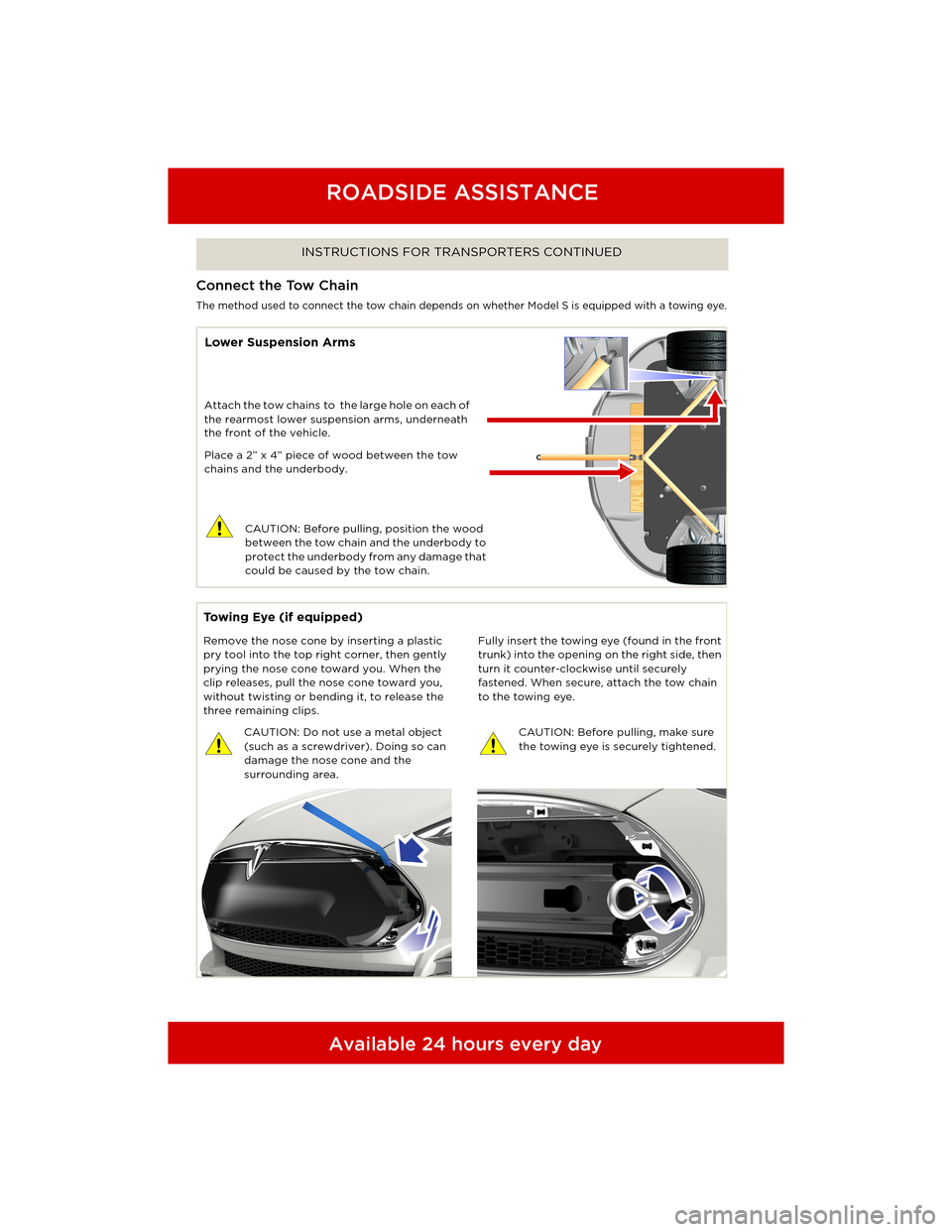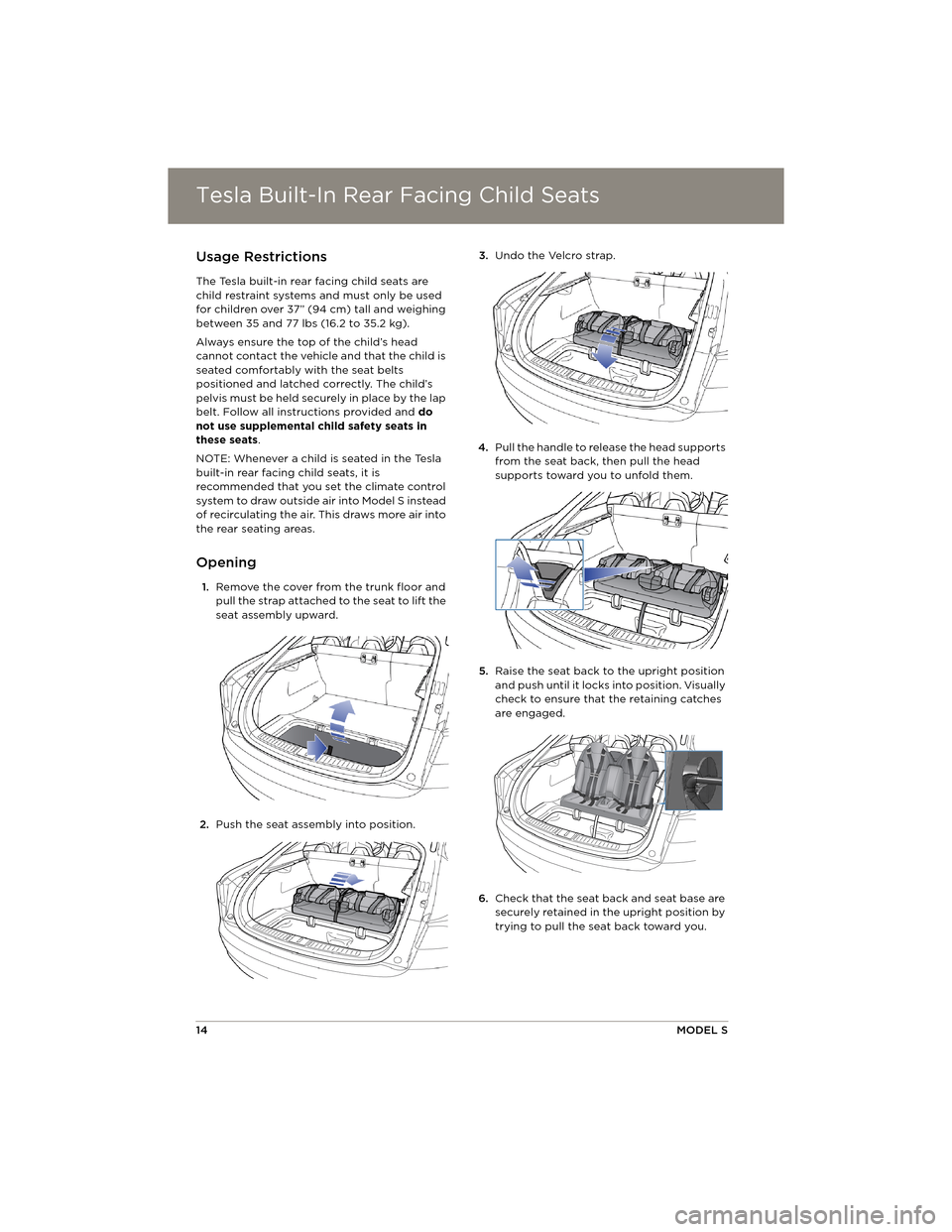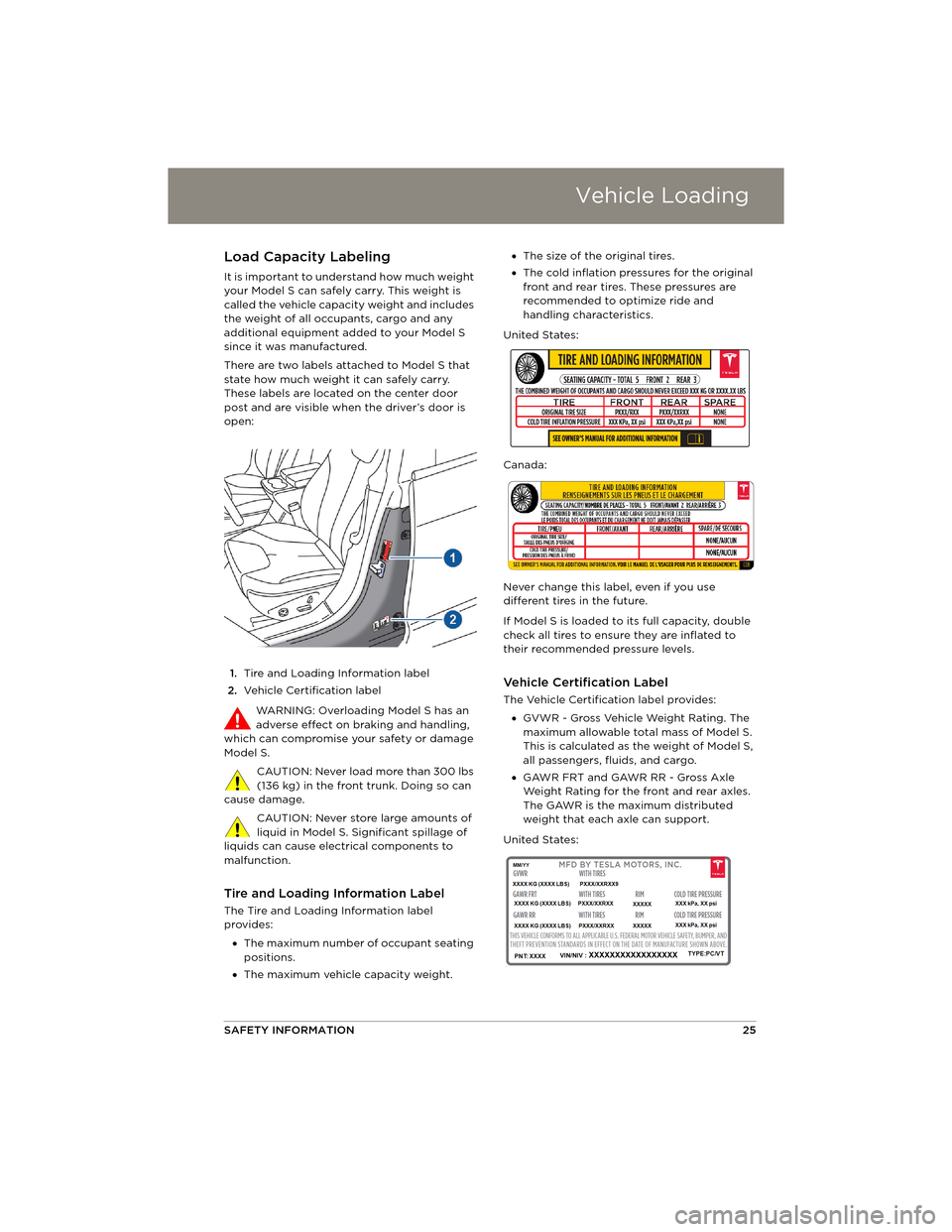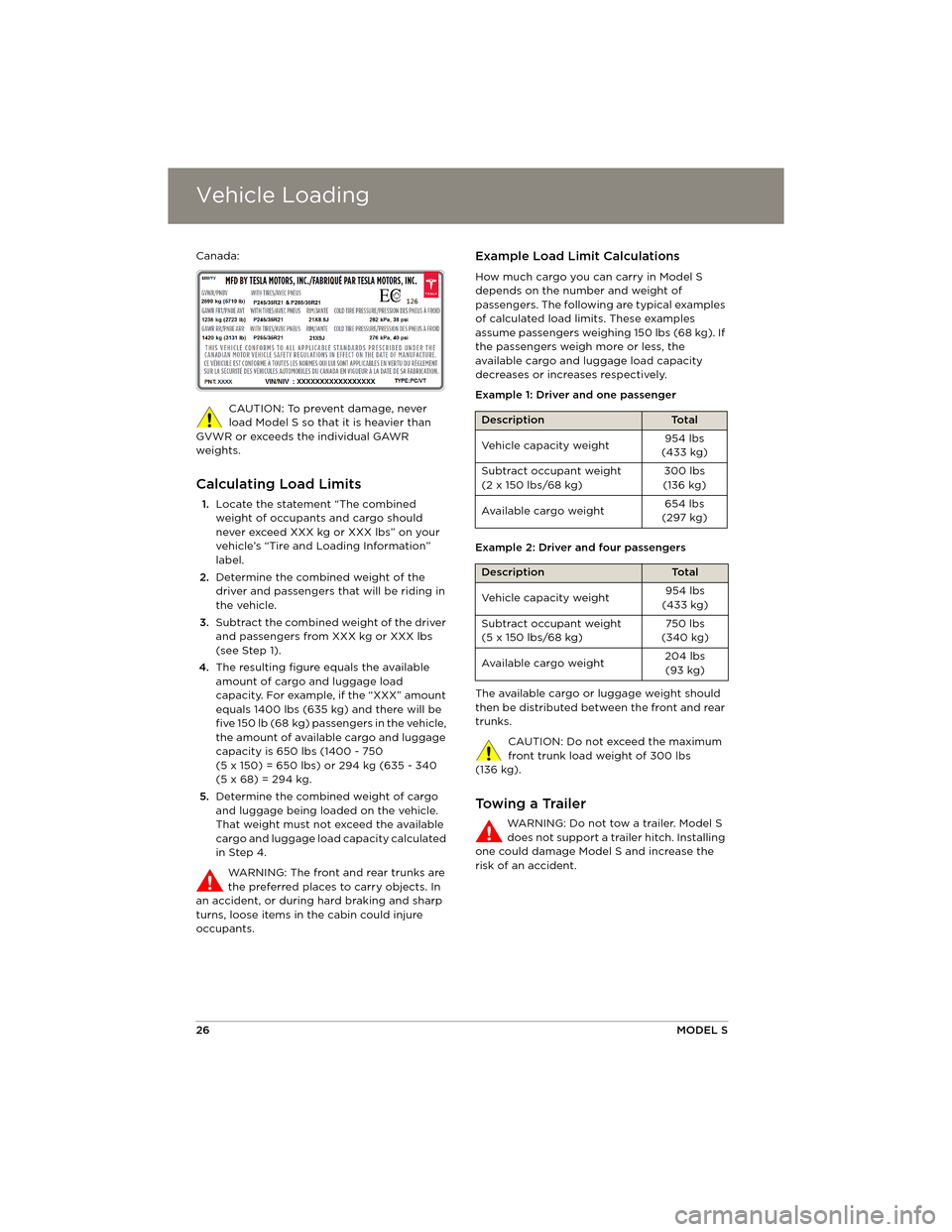trunk TESLA MODEL S 2014 Quick Guide (North America)
[x] Cancel search | Manufacturer: TESLA, Model Year: 2014, Model line: MODEL S, Model: TESLA MODEL S 2014Pages: 44, PDF Size: 5.31 MB
Page 4 of 44

Available 24 hours every day
ROADSIDE ASSISTANCE
INSTRUCTIONS FOR TRANSPORTERS CONTINUED
Connect the Tow Chain
The method used to connect the tow chain depends on whether Model S is equipped with a towing eye.
Attach the tow chains to the large hole on each of
the rearmost lower suspension arms , underneath
the front of the vehicle.
Pl
ace a 2” x 4” piece of wood between the tow
chains and the underbody.
CAUTION: Before pulling, position the wood
between the tow chain and the underbody to
protect the underbody from any damage that
could be caused by the tow chain.
Lower Suspension Arms
Remove the nose cone by inserting a plastic
pry tool into the top right corner, then gently
prying the nose cone toward you. When the
clip releases, pull the nose cone toward you,
without twisting or bending it, to release the
three remaining clips.CAUTION: Do not use a metal object
(such as a screwdriver). Doing so can
damage the nose cone and the
surrounding area.
Towing Eye (if equipped)
Fully insert the towing eye (found in the front
trunk) into the opening on the right side, then
turn it counter-clockwise until securely
fastened. When secure, attach the tow chain
to the towing eye.
CAUTION: Before pulling, make sure
the towing eye is securely tightened.
Model S Quick Guide - NA Rev C.book Page 2 Wednesday, December 18, 2013 12:40 PM
Page 16 of 44

Tesla Built-In Rear Facing Child SeatsTesla Built-In Rear Facing Child Seats
14MODEL S
Tesla Built-In Rear Facing Child SeatsUsage Restrictions
The Tesla built-in rear facing child seats are
child restraint systems and must only be used
for children over 37” (94 cm) tall and weighing
between 35 and 77 lbs (16.2 to 35.2 kg).
Always ensure the top of the child’s head
cannot contact the vehicle and that the child is
seated comfortably with the seat belts
positioned and latched correctly. The child’s
pelvis must be held securely in place by the lap
belt. Follow all instructions provided and do
not use supplemental child safety seats in
these seats .
NOTE: Whenever a child is seated in the Tesla
built-in rear facing child seats, it is
recommended that you set the climate control
system to draw outside air into Model S instead
of recirculating the air. This draws more air into
the rear seating areas.
Opening
1.Remove the cover from the trunk floor and
pull the strap attached to the seat to lift the
seat assembly upward.
2. Push the seat assembly into position. 3.
Undo the Velcro strap.
4. Pull the handle to release the head supports
from the seat back, then pull the head
supports toward you to unfold them.
5. Raise the seat back to the upright position
and push until it locks into position. Visually
check to ensure that the retaining catches
are engaged.
6. Check that the seat back and seat base are
securely retained in the upright position by
trying to pull the seat back toward you.
Model S Quick Guide - NA Rev C.book Page 14 Wednesday, December 18, 2013 12:40 PM
Page 17 of 44

Tesla Built-In Rear Facing Child Seats
SAFETY INFORMATION15
Storing
CAUTION: Before folding the seats,
fasten the seat belts to prevent them
from getting trapped in the seat
mechanism and being damaged.
1. Pull the handle to release the seat back and
pull the seat back fully forward.
2. Push the lever to release the head supports
from the seat back, then fold back onto the
seat.
3. Secure the Velcro strap. 4.
Pull the strap at the rear of the seat to fold
the seat assembly into the trunk floor.
5. Replace the cover on the trunk floor.
Model S Quick Guide - NA Rev C.book Page 15 Wednesday, December 18, 2013 12:40 PM
Page 27 of 44

Vehicle Loading
SAFETY INFORMATION25
Ve h i c l e L o a d i n gLoad Capacity Labeling
It is important to understand how much weight
your Model S can safely carry. This weight is
called the vehicle capacity weight and includes
the weight of all occupants, cargo and any
additional equipment added to your Model S
since it was manufactured.
There are two labels attached to Model S that
state how much weight it can safely carry.
These labels are located on the center door
post and are visible when the driver’s door is
open:
1. Tire and Loading Information label
2. Vehicle Certification label
WARNING: Overloading Model S has an
adverse effect on braking and handling,
which can compromise your safety or damage
Model S.
CAUTION: Never load more than 300 lbs
(136 kg) in the front trunk. Doing so can
cause damage.
CAUTION: Never store large amounts of
liquid in Model S. Significant spillage of
liquids can cause electrical components to
malfunction.
Tire and Loading Information Label
The Tire and Loading Information label
provides:
• The maximum number of occupant seating
positions.
• The maximum vehicle capacity weight. •
The size of the original tires.
• The cold inflation pressures for the original
front and rear tires. These pressures are
recommended to optimize ride and
handling characteristics.
United States:
Canada:
Never change this label, even if you use
different tires in the future.
If Model S is loaded to its full capacity, double
check all tires to ensure they are inflated to
their recommended pressure levels.
Vehicle Certification Label
The Vehicle Certification label provides: • GVWR - Gross Vehicle Weight Rating. The
maximum allowable total mass of Model S.
This is calculated as the weight of Model S,
all passengers, fluids, and cargo.
• GAWR FRT and GAWR RR - Gross Axle
Weight Rating for the front and rear axles.
The GAWR is the maximum distributed
weight that each axle can support.
United States:
Model S Quick Guide - NA Rev C.book Page 25 Wednesday, December 18, 2013 12:40 PM
Page 28 of 44

Vehicle LoadingVehicle Loading
26MODEL S
Canada:
CAUTION: To prevent damage, never
load Model S so that it is heavier than
GVWR or exceeds the individual GAWR
weights.
Calculating Load Limits
1. Locate the statement “The combined
weight of occupants and cargo should
never exceed XXX kg or XXX lbs” on your
vehicle’s “Tire and Loading Information”
label.
2. Determine the combined weight of the
driver and passengers that will be riding in
the vehicle.
3. Subtract the combined weight of the driver
and passengers from XXX kg or XXX lbs
(see Step 1).
4. The resulting figure equals the available
amount of cargo and luggage load
capacity. For example, if the “XXX” amount
equals 1400 lbs (635 kg) and there will be
f i v e 1 5 0 l b ( 6 8 k g ) p a s s e n g e r s i n t h e v e h i c l e ,
the amount of availa ble cargo and luggage
capacity is 650 lbs (1400 - 750
(5 x 150) = 650 lbs) or 294 kg (635 - 340
(5 x 68) = 294 kg.
5. Determine the combined weight of cargo
and luggage being loaded on the vehicle.
That weight must not exceed the available
cargo and luggage load capacity calculated
in Step 4.
WARNING: The front and rear trunks are
the preferred places to carry objects. In
an accident, or during hard braking and sharp
turns, loose items in the cabin could injure
occupants.
Example Load Limit Calculations
How much cargo you can carry in Model S
depends on the number and weight of
passengers. The followin g are typical examples
of calculated load limits. These examples
assume passengers weighi ng 150 lbs (68 kg). If
the passengers weigh more or less, the
available cargo and luggage load capacity
decreases or increases respectively.
Example 1: Driver and one passenger
Example 2: Driver and four passengers
The available cargo or luggage weight should
then be distributed betw een the front and rear
trunks.
CAUTION: Do not exceed the maximum
front trunk load weight of 300 lbs
(136 kg).
Towing a Trailer
WARNING: Do not tow a trailer. Model S
does not support a trailer hitch. Installing
one could damage Model S and increase the
risk of an accident.
DescriptionTo t a l
Vehicle capacity weight 954 lbs
(433 kg)
Subtract occupant weight
(2 x 150 lbs/68 kg) 300 lbs
(136 kg)
Ava i l a b l e c a rg o we i g h t 654 lbs
(297 kg)
DescriptionTo t a l
Vehicle capacity weight 954 lbs
(433 kg)
Subtract occupant weight
(5 x 150 lbs/68 kg) 750 lbs
(340 kg)
Ava i l a b l e c a rg o we i g h t 204 lbs
(93 kg)
Model S Quick Guide - NA Rev C.book Page 26 Wednesday, December 18, 2013 12:40 PM